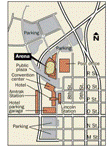Community and Regional Planning Program

Community and Regional Planning Program: Faculty Scholarly and Creative Activity
Document Type
Article
Date of this Version
2016
Citation
Published in Computers and Electronics in Agriculture 125 (2016), 11 pp. doi 10.1016/j.compag.2016.04.015
Abstract
Timely and accurate monitoring of cropping intensity (CI) is essential to help us understand changes in food production. This paper aims to develop an automatic Cropping Intensity extraction method based on the Isolines of Wavelet Spectra (CIIWS) with consideration of intra- class variability. The CIIWS method involves the following procedures: (1) characterizing vegetation dynamics from time–frequency dimensions through a continuous wavelet transform performed on vegetation index temporal profiles; (2) deriving three main features, the skeleton width, maximum number of strong brightness centers and the intersection of their scale intervals, through computing a series of wavelet isolines from the wavelet spectra; and (3) developing an automatic cropping intensity classifier based on these three features. The proposed CIIWS method improves the understanding in the spectral–temporal properties of vegetation dynamic processes. To test its efficiency, the CIIWS method is applied to China’s Henan province using 250 m 8 days composite Moderate Resolution Imaging Spectroradiometer (MODIS) Enhanced Vegetation Index (EVI) time series datasets. An overall accuracy of 88.9% is achieved when compared with in-situ observation data. The mapping result is also evaluated with 30 m Chinese Environmental Disaster Reduction Satellite (HJ-1)-derived data and an overall accuracy of 86.7% is obtained. At county level, the MODIS-derived sown areas and agricultural statistical data are well correlated (r2 = 0.85). The merit and uniqueness of the CIIWS method is the ability to cope with the complex intra-class variability through continuous wavelet transform and efficient feature extraction based on wavelet isolines. As an objective and meaningful algorithm, it guarantees easy applications and greatly contributes to satellite observations of vegetation dynamics and food security efforts.
Included in
Agricultural Economics Commons, Cultural Resource Management and Policy Analysis Commons, Environmental Monitoring Commons, Natural Resources Management and Policy Commons, Other Oceanography and Atmospheric Sciences and Meteorology Commons, Urban, Community and Regional Planning Commons


Comments
Copyright © 2016 Elsevier B.V. Used by permission.